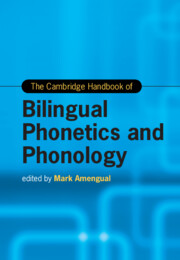Book contents
- The Cambridge Handbook of Bilingual Phonetics and Phonology
- Cambridge Handbooks in Language and Linguistics
- The Cambridge Handbook of Bilingual Phonetics and Phonology
- Copyright page
- Dedication
- Contents
- Figures
- Tables
- Contributors
- Acknowledgments
- Introduction Bilingual Phonetics and Phonology
- Part I Approaches to Bilingual Phonetics and Phonology
- Part II Theoretical Models of Bilingual Phonetics and Phonology
- Part III The Phonetics and Phonology of the Bilingual Child
- Part IV The Phonetics and Phonology of the Bilingual Adult
- 17 The Speech Perception of Bilingual Adults
- 18 The Speech Production of Bilingual Adults
- 19 Phonological Processing and Lexical Encoding in Bilingual Speech
- 20 Acquisition of Segmental Phonology in Adult Bilingualism
- 21 Acquisition of Suprasegmental Phonology in Adult Bilingualism
- Part V The Diversity of Bilingual Speakers
- Part VI Variables and Outcomes of Bilingual Speech
- Index
- References
17 - The Speech Perception of Bilingual Adults
from Part IV - The Phonetics and Phonology of the Bilingual Adult
Published online by Cambridge University Press: 14 November 2024
- The Cambridge Handbook of Bilingual Phonetics and Phonology
- Cambridge Handbooks in Language and Linguistics
- The Cambridge Handbook of Bilingual Phonetics and Phonology
- Copyright page
- Dedication
- Contents
- Figures
- Tables
- Contributors
- Acknowledgments
- Introduction Bilingual Phonetics and Phonology
- Part I Approaches to Bilingual Phonetics and Phonology
- Part II Theoretical Models of Bilingual Phonetics and Phonology
- Part III The Phonetics and Phonology of the Bilingual Child
- Part IV The Phonetics and Phonology of the Bilingual Adult
- 17 The Speech Perception of Bilingual Adults
- 18 The Speech Production of Bilingual Adults
- 19 Phonological Processing and Lexical Encoding in Bilingual Speech
- 20 Acquisition of Segmental Phonology in Adult Bilingualism
- 21 Acquisition of Suprasegmental Phonology in Adult Bilingualism
- Part V The Diversity of Bilingual Speakers
- Part VI Variables and Outcomes of Bilingual Speech
- Index
- References
Summary
This chapter outlines studies within the domain of speech perception by bilingual adult listeners. I first discuss studies that have examined bilinguals’ perception of L1 and/or L2 speech segments, as well as those that have tested perception of unfamiliar, non-native speech segments. In turn, I examine each of the factors that are known to affect bilinguals’ perception of speech, which include age of L2 acquisition, effects of L1:L2 usage as they pertain to language dominance and proficiency, and short-term contextual effects on speech perception. I also provide an overview of the literature on bilinguals’ perception of suprasegmentals. Finally, I explore what I think are some of the crucial questions facing the field of bilingual speech perception.
- Type
- Chapter
- Information
- The Cambridge Handbook of Bilingual Phonetics and Phonology , pp. 385 - 406Publisher: Cambridge University PressPrint publication year: 2024

